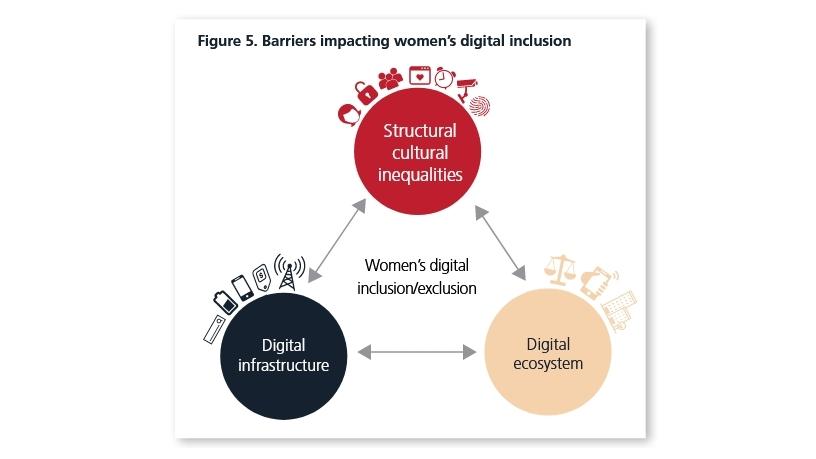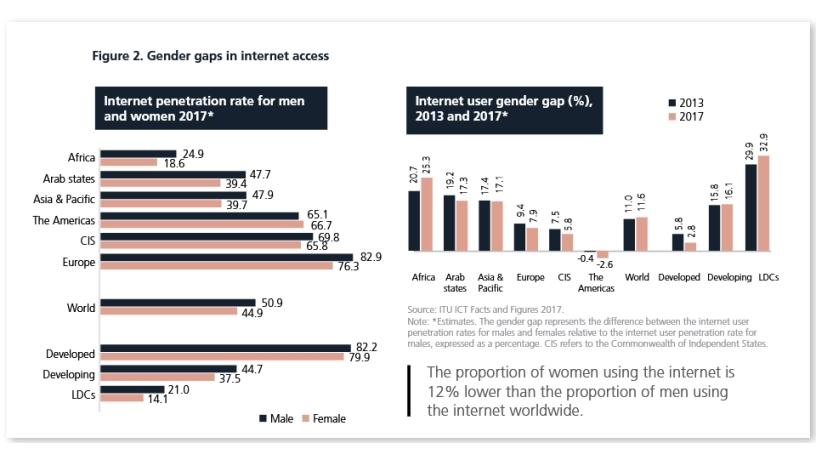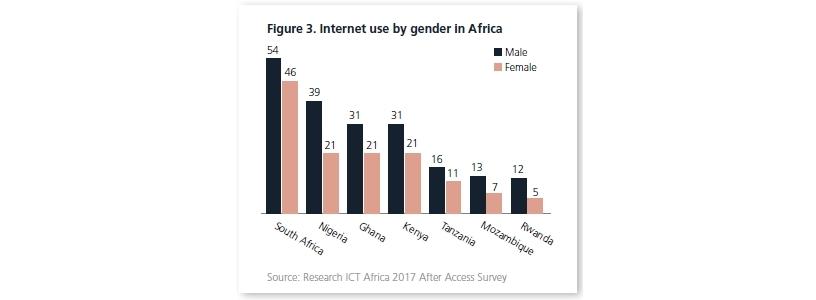
To minimise the digital gender divide, women need to be much more involved in the design and development of technologies and policies that affect their lives.
This is one of the recommendations from a report, jointly published by the Internet Society and the Association for Progressive Communications (APC), outlining ways in which policymakers can facilitate the Internet's positive potential through an enabling framework for women's digital inclusion.
"Digital policies have too often been designed and implemented with little female participation and with too little attention paid to the needs of users, particularly those who have less experience of online activity. Women should be at the forefront of digital development, not merely an afterthought," the report says.
"Overall estimates of the gender digital divide are insufficient, however, for policy and programme development. We need to reach deeper by asking women about their own experiences of the Internet, including the barriers they face in accessing it, using it, and participating in the development of it."
Another crucial aspect to consider is that national contexts vary greatly in both gender equality and digital development, and appropriate policies and interventions will also differ between different nations.
"While there are many common issues, there is no one-size-fits-all solution to the gender digital divide. If they wish to overcome digital disadvantage and promote digital development, governments, business and other stakeholders need to pay attention to these different contexts in developing those policies, programmes and business plans."
Much wider impact
The report builds on work by the G20, which in August committed to paying "special attention" to the digital gender divide, and also expressed the intention to "reflect about impactful strategies and steps to bridge the digital gender divide".
"The ability to access and use the Internet effectively is central to women's digital inclusion. Research has shown that when women gain meaningful Internet access and participate in evolving knowledge societies, it is not only women that benefit. Their families, villages, communities and countries also gain from their empowerment," the report says.
"Promoting Internet access for women is therefore much more than an issue of gender equality; it is an essential part of the economic, social and political development of the countries in which women live."
In its Digital Economy Ministerial Declaration, the G20 says the main obstacles to gender digital inclusion are access, affordability, lack of education, skills and technological literacy, and inherent gender biases and socio-cultural norms.
APC and the Internet Society add that the main barriers impacting women's digital inclusion are structural and cultural inequalities, the digital ecosystem, and digital infrastructure barriers.

Balancing skills, speed, cost
As things stand today, many women continue to be left behind in digital development.
According to the research, globally women are 12% less likely to use the Internet than men, while in low- and middle-income countries, the gap between women's use and that of men is 26%. This gender digital gap is least pronounced in developed countries, and most pronounced in least developed countries, where women are 33% less likely than men to use the Internet.
"Even when women do have access to the Internet, that access may not be available at a quality, speed or cost that enables them to use it optimally. What's more, access to the Internet is only fully meaningful when women have the skills or capacities required to use it to improve their lives and those of their families and communities.
"As economies are increasingly becoming more digital and interconnected, women's participation in global economies and fields like science, technology, engineering and mathematics is crucial."

In Africa, the Internet user gender gap has worsened over the last five years. In 2013, the gap was 20.7% but this increased to 25.3% in 2017. In general, penetration rates in Africa remain very low, with 24.9% of men in Africa using the Internet and just 18.6% of women. This is compared to Europe, where 82.9% of men use the Internet and 76.3% of women.
Data gathered by the International Telecommunication Union, the GSMA and others indicates the gender digital divide is more severe in lower-income than in higher income countries. In the least developed countries, only one out of seven women use the Internet compared with one out of five men.
Recent surveys of households and individuals in Africa, Asia and Latin America (by Research ICT Africa, LIRNEasia and DIRSI) also confirmed women are less likely to have mobile phone or Internet access in almost all of the 16 African and Asian countries that were surveyed, and the gender digital gap mirrors offline gender inequality.
Internet penetration levels are also in general far lower for women in African countries as shown in the graph below. In Rwanda, Internet penetration rates are the lowest and gender disparity is the highest.

Achieving change
APC and the Internet Society believe all stakeholders need to work together to design and encourage approaches and, where appropriate, interventions that prioritise women's digital inclusion, to ensure women can realise the full potential the Internet holds for empowerment and development regardless of gender.
"Only then will the Internet become genuinely equitable and fulfil its potential for human development. If this is not done, there is a risk that women's digital disadvantages will increase, rather than reduce, as time goes by, with adverse effects for women's empowerment and wider development. That would be a tragedy," the report says.
To achieve change, the authors believe policies and interventions need to focus on three aspects of gender inequality and digital inclusion. Policies, programmes and initiatives are required that:
1. Directly address the barriers that inhibit women's ability to access and use the Internet.
2. Mitigate the potential negative consequences for women that arise from women's unequal access to and capacity to exploit the Internet.
3. Maximise the potential positive outcomes of Internet access and use for women and women's empowerment, including policies and interventions that use the Internet to address the structural inequalities that underpin women's disempowerment overall.
The report emphasises the digital gender gap is closely interwoven with other gender inequalities that impact women around the world.
"Digital inclusion should not be pursued separately from efforts to address these wider inequalities. Synergies between them are important in both maximising benefits and mitigating risks. Working towards digital inclusion in a holistic manner, along these lines, requires collaborative action which targets the challenges and barriers that women face," it says.
Share